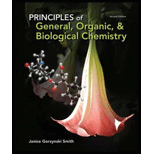
(a)
Interpretation:
The type of bonding present in potassium iodide
Concept Introduction:
Bonding:
The bonds are formed by sharing and transfer of one or more electrons present in a molecule. The atoms or ions present in a molecule are bonded together. The bonds can be formed as single, double and triple bonds. The bonds can be formed based on electronegativity value. There are few examples of bonds are given.
They are,
- Ionic bond: When electrons are transferred from metal atom to nonmetal atom, and as a result of interaction between oppositely charged ions and forms ionic bond. These types of bonds are known as ionic bonds.
- Covalent bond: These bonds are formed due to electrostatic attraction between atoms and its shared pair of electron. These bonds can able to choose their octet fill by sharing electron pairs between them. These are known as covalent bonds.
- Metallic bond: The metallic bonds are formed between ionized atoms of metal and the sea of electrons is present around them. The metal compounds generally have low electronegativity. It can be easily ionized and they can lose the outermost electron.
Electronegativity: The ability of atom to attract bonding pair of electrons is known as electronegativity. The electronegativity can be denoted as
(a)
Explanation of Solution
The potassium iodide
The compound pentane
(b)
Interpretation:
The compound potassium iodide
Concept Introduction:
Solubility:
The solubility is defined as the solid or liquid or gaseous substance which dissolves in suitable solvent. The solubilty of compounds also based on polar or nonpolar molecules. The nonpolar molecule has no separate positive and negative charge. Polar molecules have separate positive and negative charges.
(b)
Explanation of Solution
The compound potassium iodide
The compound pentane
(c)
Interpretation:
The compound potassium iodide
Concept-Introduction:
Refer: (b)
(c)
Explanation of Solution
The compound potassium iodide
Potassium iodide
The compound pentane
(d)
Interpretation:
The melting point of given compound potassium iodide
(d)
Explanation of Solution
The melting point of potassium iodide
The compound pentane
(e)
Interpretation:
The boiling point of given compound potassium iodide
(e)
Explanation of Solution
The boiling point of potassium iodide
The compound pentane
Want to see more full solutions like this?
Chapter 10 Solutions
Principles of General, Organic, Biological Chemistry
- Can I please get help with identifying these?arrow_forward4. Calculate the pH of a 0.10 M acetic acid (CH3COOH) solution if the Ka of acetic acid = 1.8 x 10-5arrow_forwardDraw the Zaitsev product of the dehydration of this alcohol. + I X 5 OH ざ~ TSOH Click and drag to start drawing a structure.arrow_forward
- Please help with identifying these.arrow_forwardFor the reaction: CO2(g) + H2(g) --> CO (g) + H2O (g) Kc= 0.64 at 900 degrees celcius. if initially you start with 1.00 atmoshpere of carbon dioxide and 1 atmoshpere of hydrogen gas, what are the equilibrium partial pressuses of all species.arrow_forwardCan I please get this answered? With the correct number of significant digits.arrow_forward
- Draw the Hofmann product of the dehydroiodination of this alkyl iodide. ☐ : + Explanation Check esc F1 2 3 I 88 % 5 F5 I. X © tBuOK Click and drag to sta drawing a structure. © 2025 McGraw Hill LLC. All Rights Reserved. Te BI BB F6 W E R Y S H Karrow_forwardCan I please get help with this graph, if you could show exactly where it needs to pass through please.arrow_forwardDraw the condensed structure of 1,3-dihydroxy-2-pentanone. Explanation Check Click anywhere to draw the first atom of your structure. Х C © 2025 McGraw Hill LLC. All Rights Reserved. Terms of use +arrow_forward
 Chemistry: The Molecular ScienceChemistryISBN:9781285199047Author:John W. Moore, Conrad L. StanitskiPublisher:Cengage LearningChemistry: Matter and ChangeChemistryISBN:9780078746376Author:Dinah Zike, Laurel Dingrando, Nicholas Hainen, Cheryl WistromPublisher:Glencoe/McGraw-Hill School Pub Co
Chemistry: The Molecular ScienceChemistryISBN:9781285199047Author:John W. Moore, Conrad L. StanitskiPublisher:Cengage LearningChemistry: Matter and ChangeChemistryISBN:9780078746376Author:Dinah Zike, Laurel Dingrando, Nicholas Hainen, Cheryl WistromPublisher:Glencoe/McGraw-Hill School Pub Co Chemistry & Chemical ReactivityChemistryISBN:9781337399074Author:John C. Kotz, Paul M. Treichel, John Townsend, David TreichelPublisher:Cengage Learning
Chemistry & Chemical ReactivityChemistryISBN:9781337399074Author:John C. Kotz, Paul M. Treichel, John Townsend, David TreichelPublisher:Cengage Learning Chemistry & Chemical ReactivityChemistryISBN:9781133949640Author:John C. Kotz, Paul M. Treichel, John Townsend, David TreichelPublisher:Cengage Learning
Chemistry & Chemical ReactivityChemistryISBN:9781133949640Author:John C. Kotz, Paul M. Treichel, John Townsend, David TreichelPublisher:Cengage Learning Chemistry: Principles and PracticeChemistryISBN:9780534420123Author:Daniel L. Reger, Scott R. Goode, David W. Ball, Edward MercerPublisher:Cengage Learning
Chemistry: Principles and PracticeChemistryISBN:9780534420123Author:Daniel L. Reger, Scott R. Goode, David W. Ball, Edward MercerPublisher:Cengage Learning Chemistry: Principles and ReactionsChemistryISBN:9781305079373Author:William L. Masterton, Cecile N. HurleyPublisher:Cengage Learning
Chemistry: Principles and ReactionsChemistryISBN:9781305079373Author:William L. Masterton, Cecile N. HurleyPublisher:Cengage Learning





